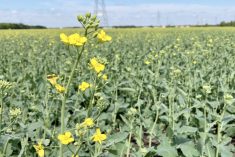MarketsFarm — With feed grain prices staying strong, Manitoba corn growers are hoping for a high yield in the face of other high-performing crops later this year.
Warren McCutcheon, a farmer from Carman, Man. and a member of the corn crop committee for the Manitoba Crop Alliance, said he expects similar acreage for this year’s crop compared to last year, citing strong prices on the markets.
“(Prices) look very optimistic. With the demand of corn, I believe (production) will stay steady, if not up a little,” he said.
Read Also

U.S. grains: Wheat futures rise on supply snags in top-exporter Russia
U.S. wheat futures closed higher on Thursday on concerns over the limited availability of supplies for export in Russia, analysts said.
While corn prices in Manitoba are more dependent on local markets and the quality of other feed grains in western Canada, the futures market is still monitored closely, McCutcheon said.
“We’re looking at the futures market and the price of corn in a place like North Dakota where our corn can be replaced. So we have to be competitive,” he said. “They’re dry (like us), so the chances of a big crop aren’t there right now, but that could change at any minute. But a lot of underlying things are very positive in the corn market.”
May contracts for corn, as of Thursday, were trading at US$5.37 per bushel on the Chicago Board of Trade (CBOT). Last month, the price reached US$5.72/bu., its highest level since July 2013.
“Corn’s very strong in comparison (to other feed grains). It’s kind of led the charge a little bit versus wheat where prices are very similar right now, which is very unusual,” McCutcheon said, adding that feed wheat and barley are starting to make a greater presence in feed. “Corn is at a premium right now.”
Manitoba farmers seeded 372,300 acres of corn in 2020, growing 1.14 million tonnes, according to Statistics Canada data. Average yields, at 122.2 bushels per acre, were in line with the five-year average. In order to have a high yield this year, rain is needed, McCutcheon said.
“Here in the Red River Valley, it’s bone dry. We haven’t had any significant moisture since last July. We didn’t get any moisture after harvest to recharge the soil. We’ve had little snowfall,” he said.
“Rain makes grain, so we’re going to be very reliant on in-season moisture this year.”
— Adam Peleshaty reports for MarketsFarm from Winnipeg.


















